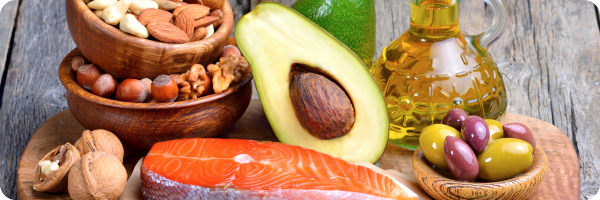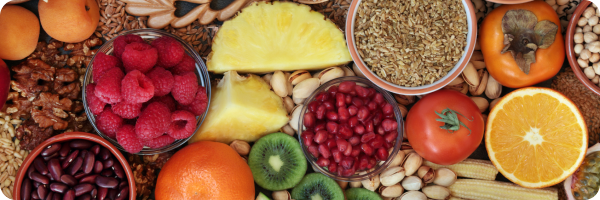What you eat won’t replace your inhalers – but it can support your lungs, ease inflammation, and help you feel more in control. Research shows that good nutrition can make a real difference for people living with asthma or COPD.
This article explains safe, evidence-backed dietary changes you can try – based on trusted guidance from organisations like the NHS, NICE, Asthma + Lung UK, and leading medical researchers.
🥗 The Mediterranean-style diet
A Mediterranean-style diet focuses on:
- Vegetables and fruit
- Whole grains (like oats, brown rice, wholemeal bread)
- Healthy fats (like olive oil, nuts, seeds)
- Legumes (like Beans and lentils)
- and oily fish
Over recent years, researchers have looked closely at how this diet may support people with lung conditions like Asthma and Chronic Obstructive Pulmonary Disease (COPD). Many of the benefits seem to come from the MedDiet’s anti-inflammatory and antioxidant properties, which can calm airway irritation and help protect the lungs.
Asthma and the Mediterranean diet
Calming inflammation
Studies show that people who stick closely to a Mediterranean-style diet often report fewer asthma symptoms and fewer attacks. For example:
- Tarazona-Meza et al. (2020) found that children who followed a Mediterranean diet had lower rates of wheezing and asthma overall.
- Mendes et al. (2021) showed that eating more vegetables – a key part of the diet – was linked with less asthma and milder symptoms in school-aged children.
These findings fit with what we already know: antioxidant-rich plant foods – ike colourful fruits and vegetables- can calm airway inflammation, which is one of the main drivers of asthma symptoms (Soczewka et al., 2025; Alwarith et al., 2020).
Healthy fats for better breathing

Foods rich in long-chain polyunsaturated fatty acids (found in fish and nuts) are another part of the MedDiet. Zhang et al. (2023) and Brustad et al. (2023) found that these healthy fats may improve the body’s response to inflammation and support better asthma control in both children and adults.
Supporting the immune system
Asthma is closely tied to how the immune system reacts to triggers. Tan et al. (2025) showed that following the MedDiet improved immune function and reduced allergic diseases, including asthma. This suggests that diet can help people become more resilient to common asthma triggers (Whyand et al., 2018).
Not the same for everyone
It’s worth noting that results vary depending on where people live and how they eat day-to-day. Domínguez et al. (2022)found differences in the diet’s effect on asthma depending on regional habits, and Zhang et al. (2019) showed no significant link in some groups.
COPD and the Mediterranean diet
Better lung function
People with COPD may also benefit from Mediterranean-style eating. In a three-year study, Iersel et al. (2022) found that those eating more fruits, fish, and vegetables had better lung function, measured by FEV1 and FVC (how much air a person can breathe out in one second and overall).
Fighting oxidative stress and inflammation
COPD is made worse by inflammation and oxidative stress. Fekete et al. (2023) found that antioxidants from fruits and vegetables in the MedDiet help reduce this damage. Scoditti et al. (2019) also showed that this diet pattern helps preserve lung function and may slow COPD progression.
Reducing flare-ups
Poor diet can potentially increase COPD flare-ups. Fard et al. (2024) reported that missing key nutrients, especially antioxidants, worsens symptoms. In contrast, Mediterranean diet components like polyphenols (plant compounds) may calm inflammation and reduce flare-up frequency and severity (Paknahad et al., 2020).
Quality of life and regional differences
Not all studies agree on the size of the benefit. Studies indicate (Zhu, 2024; Wen et al., 2023) that protective effects can differ by region and dietary customs. Still, (Fekete et al. (2023) found that people with COPD who followed the MedDiet reported better quality of life, and Patel et al. (2018) noted that this could even reduce hospital visits for flare-ups.
The bottom line
Overall, the Mediterranean diet looks like a promising approach to support lung health for people with both asthma and COPD. While results can vary across populations, the weight of evidence suggests that eating plenty of fruits, vegetables, whole grains, legumes, nuts, and healthy fats can:
- Calm inflammation in the airways
- Support better lung function
- Reduce the risk and severity of flare-ups
- Improve overall quality of life
Adopting this way of eating is not a cure, but it may be a valuable part of self-care and symptom management for people living with respiratory conditions.
Try adding one extra vegetable to your meals each day, or switch to olive oil for cooking.
🍊 Fruit and veg: Everyday protection

Fruit and vegetables are rich in antioxidants – natural substances that help protect your lungs from damage caused by pollution, smoke, or infection.
Fruits and vegetables in COPD
Several studies show that people who eat plenty of fruits and vegetables are less likely to develop COPD – and those already living with COPD may have better outcomes. In addition to being associated with better lung function (FEV1) and a lower risk of COPD (Iersel et al., 2022) as we mentioned in the Mediterranean diet segment, eating more fruits and vegetables
- Another review found that higher fruit and vegetable intake was linked with less oxidative stress and inflammation (Guo et al., 2025)
- Keranis et al. (2010) reported that COPD patients who ate more fruits and vegetables showed ongoing improvements in lung function over time, while those on standard diets did not.
The reason is clear: fruits and vegetables are packed with antioxidants, which can help protect the lungs against damage (Zhai et al., 2020).
Fruits and vegetables in asthma
The story is similar for asthma. Eating more fruit appears to offer protection against symptoms:
- A review by Seyedrezazadeh et al. (2014) found that high intakes of citrus fruits and tomatoes were linked with fewer wheezing and asthma symptoms.
- Hosseini et al. (2017) showed that fruit intake may not always reduce asthma prevalence, but it was linked with less severe asthma in some studies.
- Specific fruits may offer extra benefits – like apples, which were associated with fewer asthma cases and less airway sensitivity (Hosseini et al., 2017; Antova, 2003).
Vegetables may also help, but the research is a bit less clear. Some studies find benefits, while others don’t see a strong link – possibly because results can be affected by environmental factors and the variety of foods people eat (Sdona et al., 2021; Yang et al., 2023).
The fruit and veg takeaway
Overall, the evidence strongly supports eating more fruits and vegetables if you want to look after your lungs. From reducing inflammation to improving lung function, these foods provide natural protection against both asthma and COPD. Building meals around colourful plant foods every day may be one of the simplest and most effective steps you can take for better respiratory health.
[in green info box] Aim for 7 portions a day or more – fresh, frozen, tinned and dried all count.
Top 10 fruits and vegetables for lung health
Eating more fruits and vegetables can give your lungs natural protection. Here are ten of the best options, based on research into asthma and COPD:
- Citrus fruits (oranges, lemons, grapefruits) 🍊
- Rich in vitamin C and antioxidants. Linked with fewer asthma symptoms (Seyedrezazadeh et al., 2014).
- Tomatoes 🍅
- High in lycopene, which helps fight inflammation in the lungs. Also linked with lower wheezing and asthma symptoms (Seyedrezazadeh et al., 2014).
- Apples 🍏
- Contain flavonoids and antioxidants that may protect against asthma and airway sensitivity (Hosseini et al., 2017; Antova, 2003).
- Leafy greens (spinach, kale, chard) 🥬
- Packed with antioxidants and minerals that support immune function and reduce oxidative stress.
- Berries (blueberries, strawberries, blackberries) 🍓
- Contain polyphenols that reduce inflammation and help protect against cell damage.
- Carrots 🥕
- Rich in beta-carotene (a precursor of vitamin A), which supports lung tissue health and may reduce oxidative stress.
- Bell peppers (red, yellow, orange) 🌶️
- High in vitamin C and carotenoids – great for calming inflammation and boosting antioxidant defences.
- Legumes (peas, beans, lentils) 🫘
- Provide fibre and plant compounds that support gut health, which may also influence immune balance in asthma and COPD.
- Bananas 🍌
- Contain potassium and antioxidants that support lung function and overall respiratory health.
- Onions and garlic 🧄
- Contain sulfur compounds that have anti-inflammatory and antioxidant effects, potentially supporting airway health.
Quick tips to get more fruit and veg every day
- Add a handful of berries to your breakfast.
- Snack on carrot sticks with hummus.
- Swap crisps for apple slices with peanut butter.
- Include a side salad of leafy greens and tomatoes with lunch or dinner.
- Cook with onions and garlic as a flavour base.
For more tips from our Wellness Experts, take a look at our article on ‘How to get more vegetables’.
🐟 Omega-3 fatty acids and lung health

Omega-3 fatty acids are healthy fats found in foods like oily fish, nuts, and seeds. They are well known for helping the body fight inflammation, which is important for people with asthma or COPD. Research is growing in this area, showing how omega-3s can help calm inflammation, improve lung function, and even lower the risk of flare-ups.
Omega-3s and asthma
Omega-3 fatty acids include EPA (eicosapentaenoic acid) and DHA (docosahexaenoic acid). These fats can block other fats in the body that normally make chemicals which cause inflammation and make asthma worse. By lowering these chemicals, omega-3s may help calm swelling in the airways (Barua et al., 2023).
- Barua et al. (2023) found that omega-3 supplements improved lung function and reduced asthma attacks.
- Muley et al. (2015) showed that omega-3s may help protect against asthma, especially in children.
- Some studies suggest that when mothers take omega-3 during pregnancy, their children may have a lower risk of asthma (Miyata & Arita, 2015; Berman et al., 2016).
- Eating a Mediterranean diet, which contains plenty of omega-3s, was linked with better asthma control in adults and teenagers (Yücel et al., 2019).
- Keeping a good balance between omega-6 and omega-3 fats in the diet may also help reduce inflammation and improve breathing (Noori et al., 2011).
Omega-3s and COPD
Omega-3s may also help people with COPD, where ongoing inflammation and damage to the lungs cause symptoms to get worse.
- Research shows that omega-3 supplements can reduce inflammation and improve lung function in COPD (Miyata & Arita, 2015).
- Lang et al. (2013) found that people with asthma who had too much omega-6 compared to omega-3 in their diet responded best when they added more omega-3.
- Molfino et al. (2014) highlighted that omega-3s may not only ease COPD symptoms but also lower the risk of heart disease, which is common in people with COPD.
The Omega-3 takeaway
Omega-3 fatty acids show real promise for both asthma and COPD. They can help calm inflammation, support better breathing, and may even reduce flare-ups. More research is needed to find the best doses, but eating omega-3 rich foods is a safe and healthy step for most people.
Good sources of Omega-3
To get more omega-3s, try adding these foods into your meals:
- Oily fish: salmon, mackerel, sardines, herring, trout 🐟
- Plant-based sources: chia seeds, flaxseeds, hemp seeds, walnuts 🌱
- Fortified foods: some eggs, milks, and plant milks 🥚🥛
- Algal oil supplements: a vegan and vegetarian-friendly alternative to fish oil 🌊🌿
🌾 Fibre: Not just for digestion

A high-fibre diet (rich in whole grains, vegetables, legumes and nuts) is best known for supporting the healthy bacteria in your gut – but new research shows it may also play an important role in supporting people with asthma and COPD. Fibre is found in foods like fruit, vegetables, beans, lentils, and whole grains. When we eat fibre, it feeds our gut bacteria, which then produce special compounds called short-chain fatty acids (SCFAs). These SCFAs can help calm inflammation in the body – including in the lungs.
Fibre and COPD
High-fibre diets have been linked with lower rates of COPD and better lung function. For example:
- Iersel et al. (2022) found that people who ate more fibre had a lower risk of COPD, especially current and former smokers.
- Fard et al. (2024) reported that eating fibre from fruit and cereals was linked to a 30% reduced risk of developing COPD.
- A systematic review by Valisoltani et al. (2023) confirmed that people who ate more fibre had a significantly lower risk of COPD overall.
Researchers think this is because SCFAs, like butyrate, produced when fibre is broken down in the gut, can block pathways that cause airway inflammation. Jiang et al. (2024) showed that fibre-derived butyrate helps reduce the inflammatory processes behind COPD, which may improve lung function.
Fibre and asthma
There is also growing evidence that a high-fibre diet may protect against asthma and reduce symptoms:
- Studies suggest that children eating more fibre have lower rates of asthma symptoms. (Xie et al. (2021)
- Wen et al. (2023) reported that high-fibre diets, including plant-rich patterns like the Mediterranean diet, were linked to better asthma control.
- Park et al. (2011) observed that people who ate more fibre had lower inflammatory markers and better lung function.
Because fibre reduces inflammation, it may help calm the airway over-reactivity that drives many asthma symptoms.
The fibre takeaway
Eating a high-fibre diet may:
- Improve lung function
- Lower the risk of developing COPD
- Reduce asthma symptoms and flare-ups
- Calm airway inflammation
Adding more fibre-rich foods to your meals could be a simple, powerful way to support lung health alongside medical treatment.
Easy sources of dietary fibre
For everyday meals, try to include:
- Fruits: apples, pears, berries, citrus 🍎🍊
- Vegetables: broccoli, carrots, leafy greens 🥦🥕
- Whole grains: oats, brown rice, quinoa, wholemeal bread 🌾
- Legumes: beans, lentils, chickpeas 🫘
- Nuts and seeds: almonds, flaxseeds, chia 🌰
Add lentils to stews, swap white rice for brown, and try porridge with fruit for breakfast.
Find more information on what makes up a healthy diet.
NHS: How to get more fibre in your diet
British Dietetic Association (BDA): Food Fact Sheet – Fibre
🌞 Should you take vitamin D for asthma or COPD?

Vitamin D is often called the “sunshine vitamin” because our skin makes it when we are exposed to sunlight. It also comes from certain foods and supplements. Beyond keeping bones strong, vitamin D may play a role in supporting the lungs and reducing flare-ups in asthma and COPD.
Why Vitamin D Matters for the Lungs
Vitamin D is thought to help calm inflammation and support the immune system. This means it may lower the chance of flare-ups caused by respiratory infections, which are a common trigger for both asthma and COPD (Ilyas et al., 2019; He et al., 2024).
Many people with COPD are found to have low vitamin D levels. Research shows that being deficient is linked with more severe disease and higher risk of flare-ups. For example, Zheng et al. (2015) showed that patients with vitamin D levels below 20 ng/mL had more COPD exacerbations.
What the Research Shows
The evidence for vitamin D supplementation is mixed:
- Lokesh et al. (2020) and Khan et al. (2017) found that vitamin D supplements helped reduce flare-ups in COPD patients with low vitamin D to begin with.
- Jolliffe et al. (2019) also found benefits, but mainly in those who were most deficient. People with normal or high levels did not seem to gain much.
- For asthma, vitamin D may reduce the risk of flare-ups linked to viral infections (He et al., 2024).
Cochrane Reviews add to this picture. A Cochrane Review is one of the most trusted types of research summaries, bringing together results from many studies to show what really works in healthcare.
- For COPD, Cochrane found that vitamin D may reduce flare-ups, but mainly in people who are deficient. For others, the effect is unclear.
- For asthma, Cochrane showed some evidence that supplements can cut down on severe flare-ups, again mostly in those with low vitamin D.
Overall, this suggests vitamin D works best when used in a targeted, personalised way, based on individual levels.
Optimising vitamin D levels
The safest way to optimise vitamin D is to aim for a healthy balance:
- Sunlight: 10–20 minutes of daily sun on the skin in spring and summer (without burning).
- Diet: oily fish, eggs, fortified foods like cereals or plant milks.
- Supplements: may be needed in autumn and winter, or year-round for those at risk of deficiency.
The vitamin D takeaway
Vitamin D may help reduce asthma and COPD flare-ups, but the strongest benefits are seen in people who are already deficient. A “test and tailor” approach works best: check your levels, and if they’re low, talk to your healthcare provider about supplements. For everyone, safe sun exposure, a balanced diet, and the right supplements when needed can help keep vitamin D at healthy levels.
In the UK, the NHS recommends 10 micrograms (400 IU) daily for most adults during the darker months, and all year round for people at risk of low vitamin D.
For more information on vitamin D, including risk factors for deficiency, please check our article here.
Food triggers in asthma and COPD
Not everyone with asthma or COPD reacts to food, but for some people, certain foods or additives can make symptoms worse or even bring on a flare-up. Let’s look at what the research says about food triggers and how they might affect breathing.
Food allergies and asthma
Food allergies and asthma often show up together.
- Wan et al. (2017) found that food allergies were behind 2–8.5% of asthma flare-ups in children.
- Krogulska et al. (2015) showed that 2–9% of people with asthma also have food allergies that can make their breathing worse.
- People with asthma are more likely to report food reactions than people without asthma (Gillman & Douglass, 2010; Rentzos et al., 2015).
Food allergies can also increase inflammation in the lungs. For example, Patelis et al. (2014) showed that food allergen sensitivity was linked with higher inflammation markers. Other studies found that certain food allergies could cause stronger airway inflammation, leading to more severe asthma (Kulkarni et al., 2011; Cherian et al., 2022).
Lifestyle habits can play a role too. Saadeh et al. (2015) linked eating more fast food and trans fats with higher asthma rates in children.
In serious cases, food allergies can even trigger anaphylaxis, a life-threatening reaction that can cause sudden asthma attacks.
Dairy products

Dairy and asthma is a mixed story.
- Some research suggests dairy could trigger symptoms. Fu et al. (2023) found that sugars in dairy might worsen allergic reactions, and some older studies Demir et al. (2004) indicated that asthma in children improved when cow’s milk was removed.
- Williams et al. (2011) also reported that people living near dairy farms, and exposed to cow allergens, had worse asthma symptoms.
But other studies show no harm, and sometimes benefits:
- Jamalvandi et al. (2024) found no strong link between dairy and asthma symptoms and possibly even some protective effect especially with fermented dairy products like cheese.
- During pregnancy, eating more dairy was linked to fewer wheezing and allergy problems in babies (Maslova et al., 2012; Miyake et al., 2009).
- And a review by Wüthrich et al. (2005) found no proof that milk causes more mucus or triggers asthma.
So, for dairy, it seems to come down to the individual: Asthma caused by cow’s milk allergy is rare. While some people with asthma are told to avoid dairy, research shows that milk doesn’t usually affect lung function. Cutting out dairy without good reason can also lower important nutrients like calcium.
Sulphites in the diet and their impact on breathing

Sulphites are preservatives found in many foods and drinks, such as dried fruit, wine, beer, sauces, and packaged snacks. They help keep products fresh, but for some people with asthma – and possibly COPD – they can cause breathing problems.
What it means if you have asthma
If you have asthma, sulphites may be something to watch out for.
- Some people with asthma are sensitive to sulphites. When they eat or drink foods containing them, they may notice wheezing, coughing, tightness in the chest, or even more serious reactions.
- Reactions can range from mild discomfort to severe asthma attacks that may require urgent care (Vally & Thompson, 2003; Vally et al., 2007, 2009; Skypala et al., 2015).
- In a few cases, sulphites have also been linked to allergic-type responses, like hives or low blood pressure, alongside breathing symptoms (Curno et al., 2007).
- An EFSA (European Food Safety Authority) Panel on Food Additives and Nutrient Sources added to Food (ANS) was asked to deliver a scientific opinion on various sulphites and noted they may worsen chronic asthma symptoms.
What’s happening inside the body is that sulphites can irritate the airways and trigger inflammation, making them more “twitchy” or reactive. This explains why some people experience flare-ups after sulphite exposure.
What it means if you have COPD
The link between sulphites and COPD is less well studied, but there are some signs that sulphites may also make COPD symptoms worse. They could add to airway inflammation and sensitivity, though more research is needed to be certain.
Sulphite safety and practical tips
- Not everyone with asthma or COPD is sensitive to sulphites, but for those who are, reactions can be serious.
- Sulphites are legally allowed in food and have GRAS (Generally Recognized as Safe) status, but because of their impact on respiratory health, researchers have called for clearer labelling (Curno et al., 2007).
- Check labels carefully – by law, sulphites must be listed when present at higher levels.
- Common sources include dried fruit, wine, beer, soft drinks, sauces, and packaged snacks.
- If you suspect you’re sensitive, talk to your healthcare provider before cutting foods out.
Common food triggers to watch for
Not everyone with asthma or COPD reacts to food, but these are some of the most common triggers seen in research:
- 🥛 Dairy (milk, cheese, yoghurt) – may worsen symptoms in some people, but not all.
- 🍔 Fast food and fried foods – often high in trans fats, which have been linked with worse asthma symptoms.
- 🍇 Dried fruit (apricots, raisins, prunes) – often contain sulfites, which can trigger asthma.
- 🍷 Wine, beer, cider – sulfites in alcoholic drinks can set off wheezing or shortness of breath in sensitive people.
- 🌰 Nuts, shellfish, eggs, soy – common food allergens that may trigger severe asthma attacks in those allergic.
- 🍬 Packaged snacks and processed foods – may contain preservatives or additives (like sulfites) linked with symptoms.
Tips to stay safe
If you think food might be affecting your asthma or COPD, keep track of what you eat and how you feel. Then share this with your healthcare provider to figure out if avoiding certain foods could help your breathing.
- 📖 Check labels – sulfites and allergens must be listed on packaged foods.
- ✍️ Keep a food diary – note what you ate and any symptoms that followed.
- 👩⚕️ Talk to your healthcare provider – before cutting out major food groups, to make sure your diet stays balanced.
✅ Summary: Simple nutrition tips you can try today for asthma or COPD

Simple tips to achieve your goals:
- Add more anti-inflammatory foods: Eat more vegetables, olive oil, and whole grains
- Boost antioxidants: Include colourful fruit and veg every day
- Try oily fish: Add salmon, sardines or mackerel once a week
- Increase fibre: Choose oats, lentils, beans and wholemeal options
- Check vitamin D: Consider a supplement in winter or ask your GP
- Avoid unnecessary restrictions: Only cut out foods if advised by a health professional
🗣️ Final thought
You don’t need to make huge changes overnight. Try small swaps that suit your routine and preferences. There’s no one “perfect diet” for everyone with asthma or COPD – but the right food choices can support your lungs, your immune system, and your energy levels day to day.
If you’re unsure where to start, speak to your nurse, GP, or a registered dietitian for personalised advice.
If you haven’t already, download the free Evergreen Life app to track your health, including managing your asthma and/or COPD, and get practical tips that help you take control of your overall health.
This article is intended for general education and health coaching support and does not constitute medical advice, diagnosis, or treatment. It is designed to support adults aged 18 years and over living with asthma, COPD, or asthma–COPD overlap in better understanding how to reduce the risk of disease progression and flare-ups through evidence-informed self-management strategies.
The content aims to empower users with accessible, practical information. All references are drawn from reputable, evidence-based sources and are clearly cited.
This article should not be used in place of a medical consultation, and is not intended for children or young people under the age of 18.
Always speak to your GP, respiratory nurse, or specialist before starting, changing, or stopping any treatment or management approach – including medications, vaccinations, or lifestyle interventions.
If you experience severe breathlessness, confusion, blue lips or fingers, or symptoms that are not improving with your usual treatment, call 999 immediately.
This resource does not meet the definition of a medical device under UK MHRA regulations. It is not intended for use in diagnosing, prescribing, or making clinical decisions without appropriate professional input.
- Alwarith, Jihad & Kahleova, Hana & Crosby, Lee & Brooks, Alexa & Brandon, Lizoralia & Levin, Susan & Barnard, Neal. (2020). The role of nutrition in asthma prevention and treatment. Nutrition reviews. 78. 10.1093/nutrit/nuaa005.
- amzam Paknahad, Leila Yazdanpanah, Mohammad Reza Maracy, Amir Reza Moravejolahkami, Seyed Ali Javad-Mousavi, Abbas Nemati, Association of dietary quality indices with sleep quality in chronic obstructive pulmonary disease patients, Nutrition & Food Science, Volume 50, Issue 6, 2020, Pages 1295-1307, ISSN 0034-6659.
- Antova, T., S Pattenden, B Nikiforov, G S Leonardi, B Boeva, T Fletcher, P Rudnai, H Slachtova, C Tabak, R Zlotkowska, D Houthuijs, B Brunekreef, J Holikova, Nutrition and respiratory health in children in six Central and Eastern European countries, Thorax 2003;58:231–236.
- Barua, Uttam & Karmaker, Pranab & Saha, Arup & Mostofa, Md & Ghosh, Dilip & Biswas, Kamal. (2023). The Effects of Omega-3 Fatty Acids Supplementation in Bronchial Asthma. 11. 208-219. 10.4236/jbm.2023.114015.
- Berman, Deborah & CLINTON, Chelsea & Limb, Rachel. (2016). Prenatal Omega-3 Supplementation and Eczema Risk Among Offspring at Age 36 Months. Insights in Allergy, Asthma & Bronchitis. 2. 10.21767/2471-304X.100014.
- Brustad, Nicklas & Bønnelykke, Klaus & Chawes, Bo. (2023). Dietary prevention strategies for childhood asthma. Pediatric Allergy and Immunology. 34. 10.1111/pai.13984.
- Castro Mendes, Francisca & Paciência, Inês & Cavaleiro Rufo, João & Farraia, Mariana & Silva, Diana & Padrão, Patrícia & Delgado, Luís & Garcia‐Larsen, Vanessa & Moreira, Andre & Moreira, Pedro. (2021). Higher diversity of vegetable consumption is associated with less airway inflammation and prevalence of asthma in school‐aged children. Pediatric Allergy and Immunology. 32. 10.1111/pai.13446.
- Cherian AA, Lakshminarasappa DS, Chandrasekaran V, Chinnakali P. Food allergy in children with asthma and its correlation with level of asthma control. Health Sci Rep. 2022 Jan 6;5(1):e475. doi: 10.1002/hsr2.475. PMID: 35024460; PMCID: PMC8733844.
- Curno R, Magee EA, Edmond LM, Cummings JH. Studies of a urinary biomarker of dietary inorganic sulphur in subjects on diets containing 1-38 mmol sulphur/day and of the half-life of ingested 34SO4(2-). Eur J Clin Nutr. 2008 Sep;62(9):1106-15. doi: 10.1038/sj.ejcn.1602822. Epub 2007 May 30. PMID: 17538534.
- Demir AU, Karakaya G, Bozkurt B, Sekerel BE, Kalyoncu AF. Asthma and allergic diseases in schoolchildren: third cross-sectional survey in the same primary school in Ankara, Turkey. Pediatr Allergy Immunol. 2004 Dec;15(6):531-8. doi: 10.1111/j.1399-3038.2004.00202.x. PMID: 15610367.
- Dominguez Villoria, Maria & Vega-Hernández, María-Concepción & Cabrera, Teresa & Arriba Méndez, Sonia & Pellegrini-Belinchón, Francisco. (2022). Mediterranean diet in the Castilian plains:: Dietary patterns and childhood asthma in 6–7-year-old children from the province of Salamanca. Allergologia et Immunopathologia. 50. 91-99. 10.15586/aei.v50i5.544.
- EFSA ANS Panel (EFSA Panel on Food Additives and Nutrient Sources Added to Food), 2016. Scientific Opinion on the re-evaluation sulfur dioxide (E 220), sodium sulfite (E 221), sodium bisulfite (E 222), sodium metabisulfite (E 223), potassium metabisulfite (E 224), calcium sulfite (E 226), calcium bisulfite (E 227) and potassium bisulfite (E 228) as food additives. EFSA Journal 2016; 14(4):4438 151 pp.
- Fu Y-F, Jiang S-C, Zhang Z-W, Yang X-Y, Li Z-L, Hu J, Yuan S. Lactose and Galactose Promote the Crystallization of Human Galectin-10. Molecules. 2023; 28(4):1979.
- Gillman A, Douglass JA. What do asthmatics have to fear from food and additive allergy? Clin Exp Allergy. 2010 Sep;40(9):1295-302. doi: 10.1111/j.1365-2222.2010.03528.x. Epub 2010 May 26. PMID: 20528881.
- Guo, Xuequn & Luo, Qiu & Chen, Dongdong & Lin, Hongsheng. (2025). Risk and Protective Factors of COPD Among Smokers: A Cross-Sectional Study Using NHANES Database. International Journal of Chronic Obstructive Pulmonary Disease. 20. 1027-1038. 10.2147/COPD.S489581.
- He, Qian & Hu, Song & Xie, Jun & Ge, Yunqi & Li, Chong. (2024). Vitamin D supplementation may be beneficial in improving the prognosis of patients with chronic obstructive pulmonary disease in the intensive care unit: a retrospective study. Frontiers in medicine. 11. 1334524. 10.3389/fmed.2024.1334524.
- Hosseini, Benita & Berthon, Bronwyn & Wark, Peter & Wood, Lisa. (2017). Effects of Fruit and Vegetable Consumption on Risk of Asthma, Wheezing and Immune Responses: A Systematic Review and Meta-Analysis. Nutrients. 9. 341. 10.3390/nu9040341.
- Ilyas, Muhammad & Bukhari, Agussalim & Megawati, Megawati & Massi, Nasrum & Djaharuddin, I. & Bakri, Syakib & As’ad Armyn, Suryani & Arief, Mansyur & Bahar, Burhanuddin & Seweng, Arifin & Prihantono, Prihantono. (2019). Relationship between Vitamin D Level and Serum TNF-α Concentration on the Severity of Chronic Obstructive Pulmonary Disease. Open Access Macedonian Journal of Medical Sciences. 7. 10.3889/oamjms.2019.663.
- Jamalvandi M, Sasanfar B, Nafei Z, Behniafard N, Jafari M, Salehi-Abargouei A. Dairy intake in association with asthma symptoms among a large sample of children and adolescents: a cross-sectional study. Front Nutr. 2024 Mar 21;11:1298704. doi: 10.3389/fnut.2024.1298704. PMID: 38577161; PMCID: PMC10991747.
- Jiang, Min & Wang, Jing & Li, Zheng & Xu, Dan & Jing, Jing & Li, Fengsen & Ding, Jianbing & Li, Qifeng. (2024). Dietary Fiber-Derived Microbial Butyrate Suppresses ILC2-Dependent Airway Inflammation in COPD. Mediators of Inflammation. 2024. 10.1155/2024/6263447.
- Jolliffe DA, Greenberg L, Hooper RL, Mathyssen C, Rafiq R, de Jongh RT, Camargo CA, Griffiths CJ, Janssens W, Martineau AR. Vitamin D to prevent exacerbations of COPD: systematic review and meta-analysis of individual participant data from randomised controlled trials. Thorax. 2019 Apr;74(4):337-345. doi: 10.1136/thoraxjnl-2018-212092. Epub 2019 Jan 10. PMID: 30630893.
- Keranis E, Makris D, Rodopoulou P, Martinou H, Papamakarios G, Daniil Z, Zintzaras E, Gourgoulianis KI. Impact of dietary shift to higher-antioxidant foods in COPD: a randomised trial. Eur Respir J. 2010 Oct;36(4):774-80. doi: 10.1183/09031936.00113809. Epub 2010 Feb 11. PMID: 20150206.
- Khan, Dur & Ullah, Aziz & Randhawa, Fawad & Iqtadar, Somia & Butt, Nasir & Waheed, Khadija. (2017). Role of Vitamin D in reducing number of acute exacerbations in Chronic Obstructive Pulmonary Disease (COPD) patients. Pakistan Journal of Medical Sciences. 33. 10.12669/pjms.333.12397.
- Krogulska, Aneta & Dynowski, Jarosław & Funkowicz, Marzena & Malachowska, Beata & Wąsowska-Królikowska, Krystyna. (2015). Prevalence and Clinical Impact of IgE-Mediated Food Allergy in School Children With Asthma: A Double-Blind Placebo-Controlled Food Challenge Study. Allergy, asthma & immunology research. 7. 547-56. 10.4168/aair.2015.7.6.547.
- Kulkarni N, Ragazzo V, Costella S, Piacentini G, Boner A, O’Callaghan C, Fiocchi A, Kantar A. Eosinophilic airway inflammation is increased in children with asthma and food allergies. Pediatr Allergy Immunol. 2012 Feb;23(1):28-33. doi: 10.1111/j.1399-3038.2011.01226.x. Epub 2011 Nov 22. PMID: 22104024.
- Lang, Jason & Mougey, Edward & Allayee, Hooman & Blake, Kathryn & Lockey, Richard & Gong, Yan & Hossain, Jobayer & Killen, Kelleigh & Lima, John. (2013). Nutrigenetic Response to Omega-3 Fatty Acids in Obese Asthmatics (NOOA): Rationale and Methods. Contemporary clinical trials. 34. 10.1016/j.cct.2012.12.009.
- Lokesh KS, Chaya SK, Jayaraj BS, Praveena AS, Krishna M, Madhivanan P, Mahesh PA. Vitamin D deficiency is associated with chronic obstructive pulmonary disease and exacerbation of COPD. Clin Respir J. 2021 Apr;15(4):389-399. doi: 10.1111/crj.13310. Epub 2020 Dec 2. PMID: 33217151; PMCID: PMC8043964.
- Maslova E, Halldorsson TI, Strøm M, Olsen SF. Low-fat yoghurt intake in pregnancy associated with increased child asthma and allergic rhinitis risk: a prospective cohort study. J Nutr Sci. 2012 Jul 6;1:e5. doi: 10.1017/jns.2012.5. PMID: 23449856; PMCID: PMC3582227.
- Miyake Y, Sasaki S, Tanaka K, Hirota Y. Dairy food, calcium and vitamin D intake in pregnancy, and wheeze and eczema in infants. Eur Respir J. 2010 Jun;35(6):1228-34. doi: 10.1183/09031936.00100609. Epub 2009 Oct 19. PMID: 19840962.
- Miyata, Jun & Arita, Makoto. (2015). Role of omega-3 fatty acids and their metabolites in asthma and allergic diseases. Allergology international: official journal of the Japanese Society of Allergology. 64. 27-34. 10.1016/j.alit.2014.08.003.
- Molfino, Alessio & Gioia, Gianfranco & Fanelli, Filippo & Muscaritoli, Maurizio. (2014). The Role for Dietary Omega-3 Fatty Acids Supplementation in Older Adults. Nutrients. 6. 4058-4072. 10.3390/nu6104058.
- Mónika, Fekete & Csipo, Tamas & Fazekas-Pongor, Vince & Madarász, Bálint & Csizmadia, Zoltán & Tarantini, Stefano & Varga, János. (2023). The Possible Role of Food and Diet in the Quality of Life in Patients with COPD—A State-of-the-Art Review. Nutrients. 15. 3902. 10.3390/nu15183902.
- Muley, Prasad & Shah, Monali & Muley, Arti. (2015). Omega-3 Fatty Acids Supplementation in Children to Prevent Asthma: Is It Worthy?-A Systematic Review and Meta-Analysis. Journal of allergy. 2015. 312052. 10.1155/2015/312052.
- Nazanin Noori, Ramanath Dukkipati, Csaba P. Kovesdy, John J. Sim, Usama Feroze, Sameer B. Murali, Rachelle Bross, Debbie Benner, Joel D. Kopple, Kamyar Kalantar-Zadeh, Dietary Omega-3 Fatty Acid, Ratio of Omega-6 to Omega-3 Intake, Inflammation, and Survival in Long-term Hemodialysis Patients, American Journal of Kidney Diseases, Volume 58, Issue 2, 2011, Pages 248-256, ISSN 0272-6386.
- NHS (2023), Anaphylaxis, https://www.nhs.uk/conditions/anaphylaxis/.
- Özbey Yücel, Ümüş & Uçar, Aslı & Çalış, Aliye. (2019). The effects of obesity on pulmonary function in adults with asthma. Lung India.
- Park, Yikyung & Subar, Amy & Hollenbeck, Albert & Schatzkin, Arthur. (2011). Dietary fiber intake and mortality in the NIH-AARP Diet and Health Study. Archives of internal medicine. 171. 1061-8. 10.1001/archinternmed.2011.18.
- Patel, Jeetvan & Coutinho, Anna & Lunacsek, Orsolya & Dalal, Anand. (2018). COPD affects worker productivity and health care costs. International Journal of Chronic Obstructive Pulmonary Disease. 13. 2301-2311. 10.2147/COPD.S163795.
- Patelis A, Janson C, Borres MP, Nordvall L, Alving K, Malinovschi A. Aeroallergen and food IgE sensitization and local and systemic inflammation in asthma. Allergy 2014; 69: 380–387.
- Rentzos G, Johanson L, Sjölander S, Telemo E, Ekerljung L. Self-reported adverse reactions and IgE sensitization to common foods in adults with asthma. Clin Transl Allergy. 2015 Jul 17;5:25. doi: 10.1186/s13601-015-0067-6. PMID: 26191401; PMCID: PMC4506426.
- Saadeh D, Salameh P, Caillaud D, Charpin D, De Blay F, Kopferschmitt C, Lavaud F, Annesi-Maesano I, Baldi I, Raherison C. Prevalence and association of asthma and allergic sensitization with dietary factors in schoolchildren: data from the french six cities study. BMC Public Health. 2015 Sep 30;15:993. doi: 10.1186/s12889-015-2320-2. PMID: 26423141; PMCID: PMC4589972.
- Scoditti, Egeria & Massaro, Marika & Garbarino, Sergio & Toraldo, Domenico. (2019). Role of Diet in Chronic Obstructive Pulmonary Disease Prevention and Treatment. Nutrients. 11. 1357. 10.3390/nu11061357.
- Sdona, Emmanouela & Ekström, Sandra & Andersson, Niklas & Hallberg, Jenny & Rautiainen, Susanne & Håkansson, Niclas & Wolk, Alicja & Kull, Inger & Melen, Erik & Bergström, Anna. (2021). Fruit, vegetable and dietary antioxidant intake in school age, respiratory health up to young adulthood. Clinical & Experimental Allergy. 52. 10.1111/cea.14020.
- Seyedrezazadeh, Ensiyeh & Moghaddam, Masoud & Ansarin, Khalil & Vafa, Mohammad Reza & Sharma, Sangita & Kolahdooz, Fariba. (2014). Fruit and vegetable intake and risk of wheezing and asthma: A systematic review and meta-analysis. Nutrition reviews. 72. 10.1111/nure.12121.
- Skypala, Isabel & Williams, Marianne & Reeves, Liane & Meyer, Rosan & Venter, Carina. (2015). Sensitivity to food additives, vaso-active amines and salicylates: A review of the evidence. Clinical and translational allergy. 5. 10.1186/s13601-015-0078-3.
- Soczewka, Monika & Waśniowska, Justyna & Skowrońska, Bogda & Szczepankiewicz, Aleksandra & Wojsyk-Banaszak, Irena & Kedzia, Andrzej & Niechciał, Elżbieta. (2025). Effects of Nutritional Education and Diet on Obesity and Asthma Progression in Children and Adolescents. Nutrients. 17. 1759. 10.3390/nu17111759.
- Tan, Kaiyue & Sun, Nanren & Chen, Jiaojiao & Long, Jiaqi & Feng, Wenzhe & Zhang, Xiaojie & Tan, Zhimin. (2025). Adherence to the Mediterranean diet and allergic diseases in Korean adults: KNHANES 2013–2016. Frontiers in Nutrition. 12. 10.3389/fnut.2025.1563251.
- Tarazona-Meza, C.E., Hanson, C., Pollard, S.L. et al. Dietary patterns and asthma among Peruvian children and adolescents. BMC Pulm Med 20, 63 (2020).
- Vahedi Fard, Mohammad & Mohammadhasani, Kimia & Dehnavi, Zahra & Khorasanchi, Zahra. (2024). Chronic Obstructive Pulmonary Disease: The Role of Healthy and Unhealthy Dietary Patterns—A Comprehensive Review. Food Science & Nutrition. 12. 9875-9892. 10.1002/fsn3.4519.
- Valisoltani, Neda & Ghoreishy, Seyed Mojtaba & Imani, Hossein & Rajabi Harsini, Asma & Jowshan, Mohammadreza & Travica, Nikolaj & Mohammadi, Hamed. (2023). Fiber intake and risk of chronic obstructive pulmonary disease: A systematic review and dose response meta‐analysis. Food Science & Nutrition. 11. 10.1002/fsn3.3640.
- Vally H, Misso NL, Madan V. Clinical effects of sulphite additives. Clin Exp Allergy. 2009 Nov;39(11):1643-51. doi: 10.1111/j.1365-2222.2009.03362.x. Epub 2009 Sep 22. PMID: 19775253.
- Vally H, Thompson PJ. Allergic and asthmatic reactions to alcoholic drinks. Addict Biol. 2003 Mar;8(1):3-11. doi: 10.1080/1355621031000069828. PMID: 12745410.
- Vally, H., Thompson, P.J. and Misso, N.L.A. (2007), Changes in bronchial hyperresponsiveness following high- and low–sulphite wine challenges in wine-sensitive asthmatic patients. Clinical & Experimental Allergy, 37: 1062-1066.
- van Iersel, Lieke & Beijers, Rosanne & Gosker, Harry & Schols, Annemie. (2021). Nutrition as a modifiable factor in the onset and progression of pulmonary function impairment in COPD: a systematic review. Nutrition Reviews. 80. 10.1093/nutrit/nuab077.
- Wan, K. S., Wu, W. F., Liu, Y. C., Huang, C. S., Wu, C. S., Hung, C. W., & Chang, Y. S. (2017). Effects of food allergens on asthma exacerbations in schoolchildren with atopic asthma. Food and Agricultural Immunology, 28(2), 310–314.
- Wen, Jingli & Gu, Shujun & Wang, Xinyu & Qi, Xu. (2023). Associations of adherence to the DASH diet and the Mediterranean diet with chronic obstructive pulmonary disease among US adults. Frontiers in Nutrition. 10. 10.3389/fnut.2023.1031071.
- Whyand, T. & Hurst, J. & Beckles, M. & Caplin, Martyn. (2018). Pollution and respiratory disease: Can diet or supplements help? A review. Respiratory Research. 19. 79. 10.1186/s12931-018-0785-0.
- Williams, D.L., Breysse, P.N., McCormack, M.C. et al. Airborne cow allergen, ammonia and particulate matter at homes vary with distance to industrial scale dairy operations: an exposure assessment. Environ Health 10, 72 (2011).
- Williamson A, Martineau AR, Jolliffe D, Sheikh A, Janssens W, Sluyter J, Rafiq R, de Jongh R, Griffiths CJ. Vitamin D for the management of chronic obstructive pulmonary disease. Cochrane Database of Systematic Reviews 2024, Issue 9. Art. No.: CD013284. DOI: 10.1002/14651858.CD013284.pub2.
- Williamson A, Martineau AR, Sheikh A, Jolliffe D, Griffiths CJ. Vitamin D for the management of asthma. Cochrane Database of Systematic Reviews 2023, Issue 2. Art. No.: CD011511. DOI: 10.1002/14651858.CD011511.pub3. Accessed 04 September 2025.
- Wüthrich, B., Schmid, A., Walther, B., & Sieber, R. (2005). Milk Consumption Does Not Lead to Mucus Production or Occurrence of Asthma. Journal of the American College of Nutrition, 24(sup6), 547S-555S.
- Xie A, Song J, Lu S, Liu Y, Tang L, Wen S. Influence of Diet on the Effect of the Probiotic Lactobacillus paracasei in Rats Suffering From Allergic Asthma. Front Microbiol. 2021 Sep 27;12:737622. doi: 10.3389/fmicb.2021.737622. PMID: 34659167; PMCID: PMC8516095.
- Yang, Wenwen & Yang, Yanjiang & He, Li & Zhang, Min & Sun, Shuo & Wang, Feng & Han, Biao. (2023). Dietary factors and risk for asthma: A Mendelian randomization analysis. Frontiers in Immunology. 14. 10.3389/fimmu.2023.1126457.
- Zhai, Hongrui & Wang, Yu & Jiang, Wenjie. (2020). Fruit and Vegetable Intake and the Risk of Chronic Obstructive Pulmonary Disease: A Dose-Response Meta-Analysis of Observational Studies. BioMed Research International. 2020. 1-12. 10.1155/2020/3783481.
- Zhang Y, Lin J, Fu W, Liu S, Gong C, Dai J. Mediterranean diet during pregnancy and childhood for asthma in children: A systematic review and meta-analysis of observational studies. Pediatric Pulmonology. 2019; 54: 949-961.
- Zhang, Jin & He, Mengyang & Yu, Qiduo & Xiao, Fei & Zhang, Yongming & Liang, Chaoyang. (2023). The Effects of a Healthy Diet on Asthma and Wheezing in Children and Adolescents: A Systematic Review and Meta-Analysis. Journal of Asthma and Allergy. 16. 1007-1024. 10.2147/JAA.S423884.
- Zhu, Biyuan & Zhu, Biqing & Xiao, Chaolie & Zheng, Zhiwen. (2015). Vitamin D deficiency is associated with the severity of COPD: a systematic review and meta-analysis. International Journal of Chronic Obstructive Pulmonary Disease. 10. 1907-1916. 10.2147/COPD.S89763.
- Zhu,W. (2024). Relationship between diet and chronic obstructive pulmonary disease. Theoretical and Natural Science,40,228-233.





